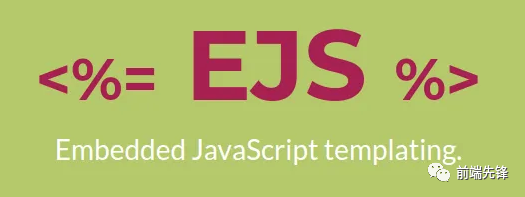Author: Alex Ronin
Translator: Crazy Technology House
Original: https://frontnet.eu/node-js-v...
Reproduction is strictly prohibited without permission
Node js view engine is like Blade in Laravel. The most basic definition is that the view engine is a tool that helps us write HTML code and reuse it in a shorter and simpler way than usual. In addition, it can import data from the server side and render the final HTML. Some common view engines in Node.js projects are as follows:
What is Nod.js View Engine?

- EJS
- Pug (Formerly Jade)
- Handlebars
- Haml.js
- Nunjucks
- ...
Today I will try some of the above templates to see which one is easier to use. Let's get started!
EJS

First of all, to create a demo program for this article, we need to use ExpressJS Create a project. This project can be created quickly with express-generator.
sudo npm install express-generator -g express --view=ejs Demo_EJS
When running the above command to create a project with Node.js ejs view engine, our project has the following directory structure:

With the above command, we created an Express project using the EJS view engine. The view engine is set in the app.js file as follows:
//... //view engine setup app.set('views', path.join(__dirname, 'views')); app.set('view engine', 'ejs'); //...
Next, I'll show you how to use it. I'll create the basic layout of the website and render the data from the server. First, the data is rendered from the server.
Edit routes/index.js file:
var express = require('express'); var router = express.Router(); /* GET home page. */ router.get('/', function(req, res, next) { let list = [ {name: 'PHP'}, {name: 'Ruby'}, {name: 'Java'}, {name: 'Python'}, {name: 'dotNet'}, {name: 'C#'}, {name: 'Swift'}, {name: 'Pascal'}, ] res.render('index', {title: 'Demo Ejs', list: list}); }); module.exports = router;
index.ejs file content:
<!DOCTYPE html> <html> <head> <title><%= title %></title> <link rel='stylesheet' href='/stylesheets/style.css' /> </head> <body> <header> <h3>This is header</h3> </header> <main> <h1><%= title %></h1> List of programming languages <ul> <% list.forEach(function(item) {%> <li><%= item.name %></li> <%}); %> </ul> </main> <footer> <h3>This is footer</h3> </footer> </body> </html>
We have implemented rendering of views on the server. In addition, we can split the header and footer by adding the header.ejs file, and then include the following footnotes:
<!DOCTYPE html> <html> <head> <title><%= title %></title> <link rel='stylesheet' href='/stylesheets/style.css' /> </head> <body> <header> <% include header %> </header> <main> <h1><%= title %></h1> List of programming languages <ul> <% list.forEach(function(item) {%> <li><%= item.name %></li> <%}); %> </ul> </main> <footer> <% include footer %> </footer> </body> </html>
Pug

Pug - formerly known as Jade, is also a popular Node.js view engine project. To use it, set the view engine as follows:
//view engine setup app.set('views', path.join(__dirname, 'views')); app.set('view engine', 'pug');
Using the example above, we created a pug file with the following contents:
//file layout.pug doctype html html head title= title link(rel='stylesheet', href='/stylesheets/style.css') body include header block content include footer //file index.pug extends layout block content h1= title | List of programming languages ul each item in list li= item.name
We can see that in the same content, Pug's code is so clear, concise and easy to understand. Pug works in much the same way as Python, even with indentation or spaces.
Hbs (Handlebars.js)

To use this template, you need to set the engine view to hbs. At the same time, blocks (called partial in handlebarjs) must be registered as follows:
var hbs = require('hbs'); hbs.registerPartials(__dirname + '/views/partials'); app.set('views', path.join(__dirname, 'views')); app.set('view engine', 'hbs');
To address the above problems, we will also create hbs files with the following contents:
// file layout.hbs <!DOCTYPE html> <html> <head> <title>{{title}}</title> <link rel='stylesheet' href='/stylesheets/style.css' /> </head> <body> {{> header}} {{{body}}} {{> footer}} </body> </html><code class="language-javascript"> // file /views/partials/header.hbs <h3>This is header</h3> //file /views/partials/footer.hbs <h3> This is footer </h3> //file index.hbs <h1> {{title}} </h1> List of programming languages <ul> {{#each list}} <li> {{name}} </li> {{/each }} </ul>
conclusion
I tested some popular view engines in the Nodejs project. You can choose Pug in your development work because it's very simple and easy to understand.
Wechat Public Number: Front-end Pioneer
Welcome to scan the two-dimensional code, pay attention to the public number, and push you fresh front-end technical articles every day.
Welcome to continue reading other highly praised articles in this column:
- Deep Understanding of Shadow DOM v1
- Step by step teach you how to use WebVR to implement virtual reality games
- Thirteen Modern CSS Frameworks to Improve your Development Efficiency
- Fast Start Bootstrap Vue
- How does the JavaScript engine work? Everything you need to know from call stack to Promise
- WebSocket Reality: Real-time Communication between Node and React
- 20 interview questions about Git
- In-depth analysis of Node.js console.log
- What exactly is Node.js?
- Build an API server with Node.js in 30 minutes
- Object Copy of Javascript
- Programmers earn less than 30K a month before they are 30 years old. Where to go?
- 14 Best JavaScript Data Visualization Libraries
- Eight top-level VS Code extension plug-ins for the front end
- Complete guide to Node.js multithreading
- Four Solutions and Implementation of Converting HTML to PDF
